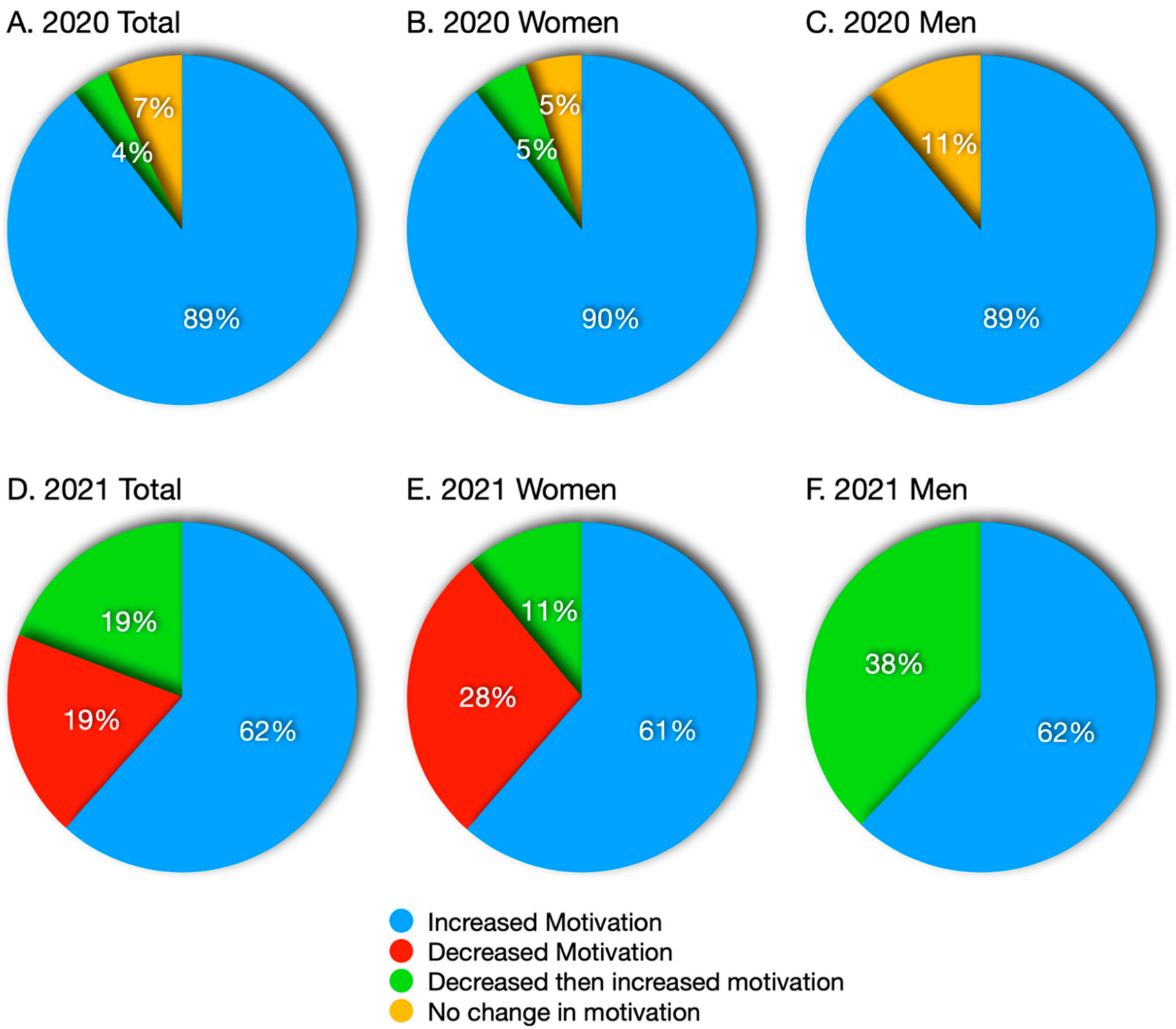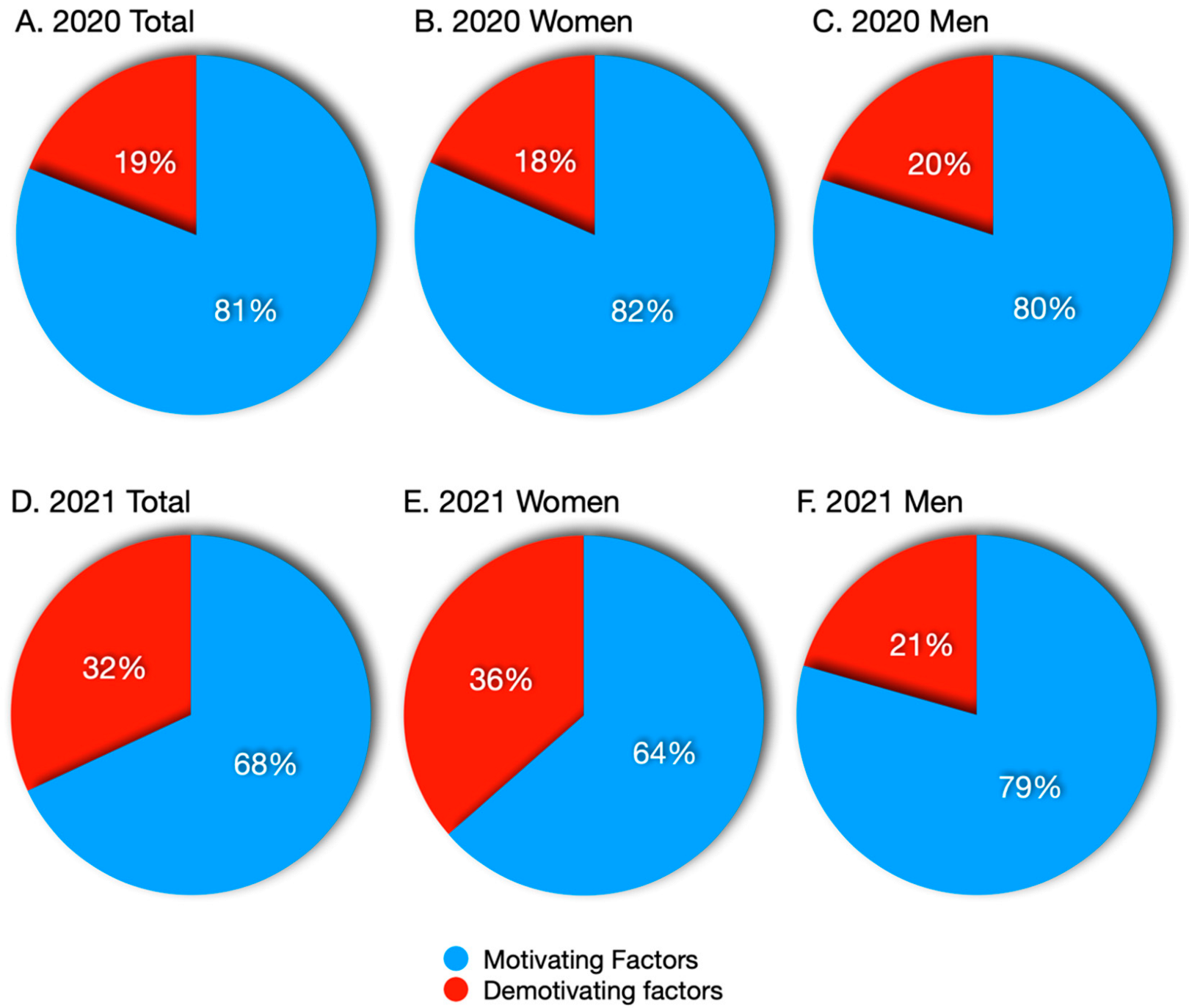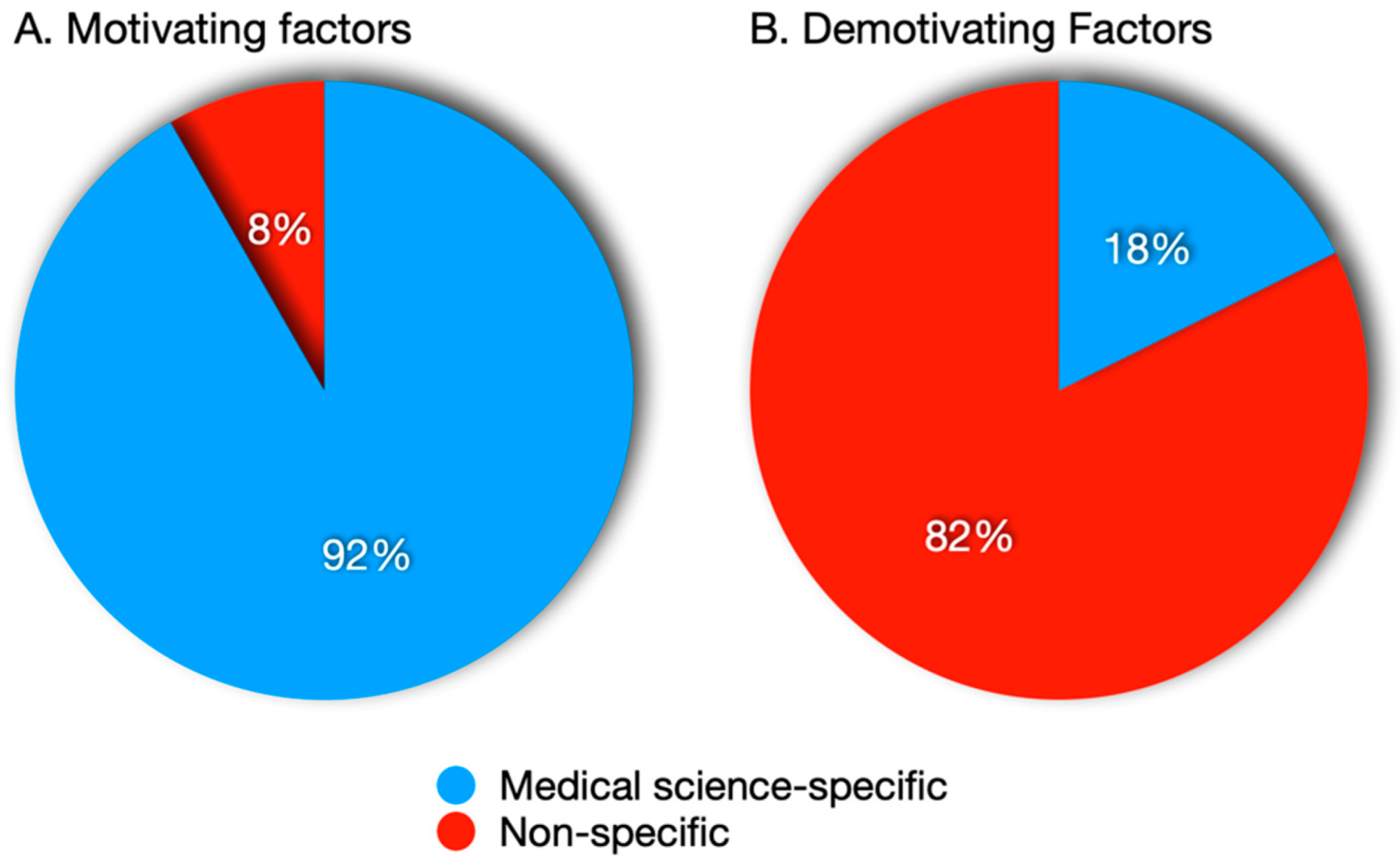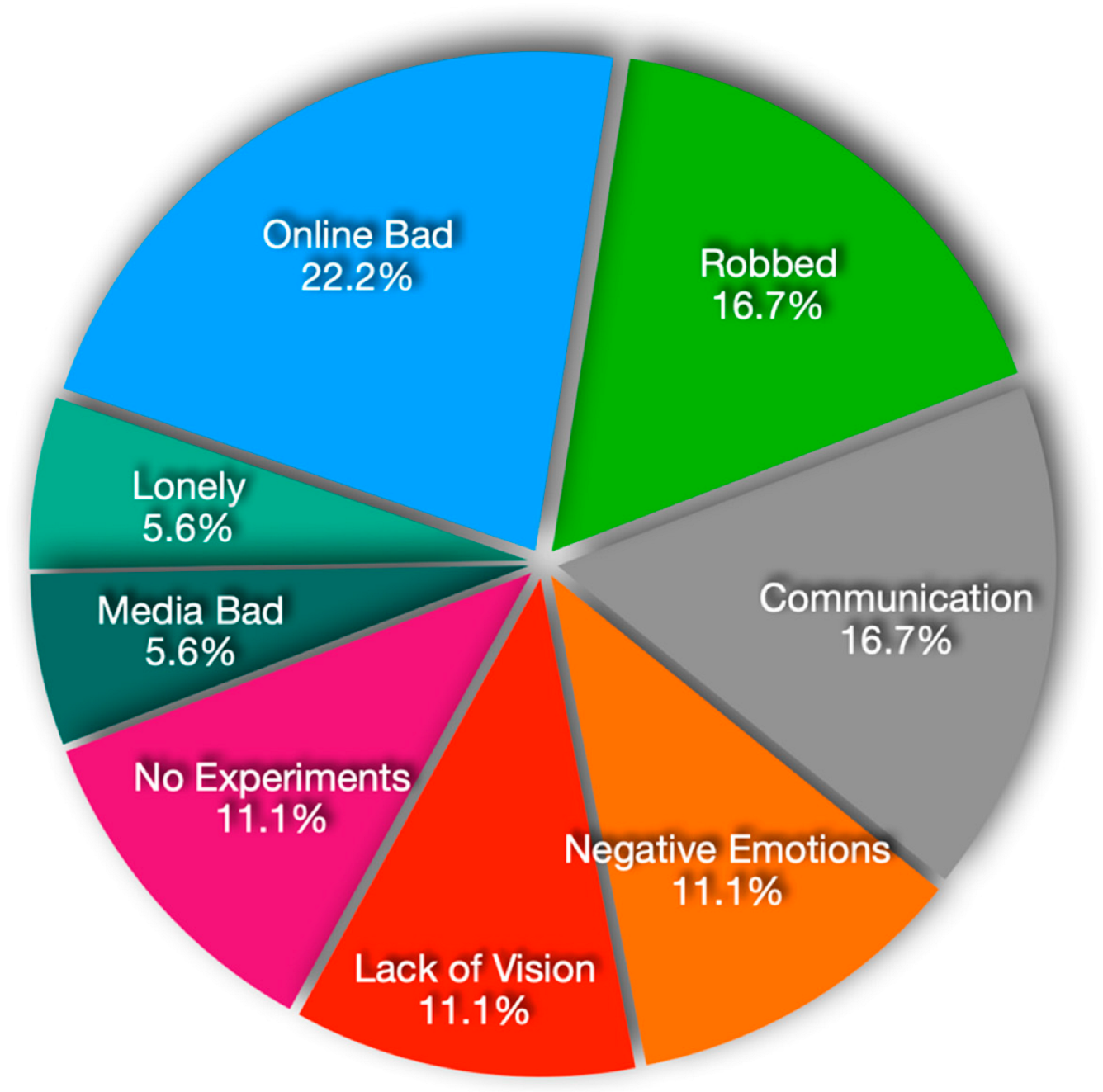Factors Affecting Undergraduate Medical Science Students’ Motivation to Study during the COVID-19 Pandemic
Abstract
:1. Introduction
2. Materials and Methods
2.1. Study Design and Participants
2.2. Data Collection
2.3. Data Analyses
3. Results
3.1. Motivation Status
3.2. Coding Analysis
4. Discussion
4.1. Implications
“Being a clinical laboratory technician is a job to be proud of. The COVID-19 pandemic has caused a lot of talk about health care workers putting their lives on the line for their work. Clinical laboratory technicians are also part of the medical profession. The clinical laboratory technician has been an inconspicuous occupation, but this time, it has attracted a lot of attention. But clinical laboratory technicians are responsible for intervening in the field of medicine, and I thought it was a job I could be proud of”.
4.2. Limitations
5. Conclusions
Supplementary Materials
Author Contributions
Funding
Institutional Review Board Statement
Informed Consent Statement
Data Availability Statement
Acknowledgments
Conflicts of Interest
References
- Burki, T.K. COVID-19: Consequences for higher education. Lancet Oncol. 2020, 21, 758. [Google Scholar] [CrossRef]
- Almendingen, K.; Morseth, M.S.; Gjølstad, E.; Brevik, A.; Tørris, C. Student’s experiences with online teaching following COVID-19 lockdown: A mixed methods explorative study. PLoS ONE 2021, 16, e0250378. [Google Scholar] [CrossRef] [PubMed]
- Al-Balas, M.; Al-Balas, H.I.; Jaber, H.M.; Obeidat, K.; Al-Balas, H.; Aborajooh, E.A.; Al-Taher, R.; Al-Balas, B. Distance learning in clinical medical education amid COVID-19 pandemic in Jordan: Current situation, challenges, and perspectives. BMC Med. Educ. 2020, 20, 341. [Google Scholar] [CrossRef]
- Shahrvini, B.; Baxter, S.L.; Coffey, C.S.; MacDonald, B.V.; Lander, L. Pre-clinical remote undergraduate medical education during the COVID-19 pandemic: A survey study. BMC Med. Educ. 2021, 21, 13. [Google Scholar] [CrossRef] [PubMed]
- Harries, A.J.; Lee, C.; Jones, L.; Rodriguez, R.M.; Davis, J.A.; Boysen-Osborn, M.; Kashima, K.J.; Krane, N.K.; Rae, G.; Kman, N.; et al. Effects of the COVID-19 pandemic on medical students: A multicenter quantitative study. BMC Med. Educ. 2021, 21, 14. [Google Scholar] [CrossRef]
- Turana, Y.; Primatanti, P.A.; Sukarya, W.S.; Wiyanto, M.; Duarsa, A.B.S.; Wratsangka, R.; Adriani, D.; Sasmita, P.K.; Budiyanti, E.; Anditiarina, D.; et al. Impact on Medical Education and the Medical Student’s Attitude, Practice, Mental Health, After One Year of the Covid-19 Pandemic in Indonesia. Front. Educ. 2022, 7, 843998. [Google Scholar] [CrossRef]
- Mathis, B.J.; Mayers, T.; Miyamasu, F. English as a Vocational Passport: Japanese Medical Students and Second Language Learning Motivation. Educ. Sci. 2022, 12, 8. [Google Scholar] [CrossRef]
- Pelaccia, T.; Viau, R. Motivation in medical education. Med. Teach. 2016, 39, 136–140. [Google Scholar] [CrossRef]
- Mayers, T.; Mathis, B.J.; Ho, C.K.; Morikawa, K.; Hisatake, K. The impact of the COVID-19 pandemic on medical science students’ motivation to study: Preliminary findings. J. Med. Eng. Educ. 2021, 20, 52–55. [Google Scholar]
- Coe, K.; Scacco, J.M. Content Analysis, Quantitative. In The International Encyclopedia of Communication Research Methods; Matthes, J., Davis, C.S., Potter, R.F., Eds.; Wiley: Hoboken, NJ, USA, 2017; pp. 1–11. [Google Scholar] [CrossRef]
- Berg, B.L. Qualitative Research Methods for the Social Sciences, 4th ed.; Allyn & Bacon: Boston, MA, USA, 2011. [Google Scholar]
- Lincoln, Y.S.; Guba, E.G. Naturalistic Inquiry; Sage Publications: Beverly Hills, CA, USA, 1985. [Google Scholar]
- Roberts, C.W. Other Than Counting Words: A Linguistic Approach to Content Analysis. Soc. Forces 1989, 68, 147–177. [Google Scholar] [CrossRef]
- Krippendorff, K. Estimating the Reliability, Systematic Error and Random Error of Interval Data. Educ. Psychol. Meas. 1970, 30, 61–70. [Google Scholar] [CrossRef]
- Cohen, J. Statistical Power Analysis for the Behavioral Sciences, 2nd ed.; Routledge: New York, NY, USA, 1988; pp. 1–567. [Google Scholar] [CrossRef]
- Beckler, D.T.; Thumser, Z.C.; Schofield, J.S.; Marasco, P.D. Reliability in evaluator-based tests: Using simulation-constructed models to determine contextually relevant agreement thresholds. BMC Med. Res. Methodol. 2018, 18, 141. [Google Scholar] [CrossRef] [PubMed]
- Engzell, P.; Frey, A.; Mark, D.; Verhagen, M.D. Learning loss due to school closures during the COVID-19 pandemic. Proc. Natl. Acad. Sci. USA 2021, 118, e2022376118. [Google Scholar] [CrossRef] [PubMed]
- Maan, A.T.; Abid, G.; Butt, T.H.; Ashfaq, F.; Ahmed, S. Perceived organizational support and job satisfaction: A moderated mediation model of proactive personality and psychological empowerment. Future Bus. J. 2020, 6, 21. [Google Scholar] [CrossRef]
- Roozenbeek, J.; Schneider, C.R.; Dryhurst, S.; Kerr, J.; Freeman, A.L.J.; Recchia, G.; van der Bles, A.M.; van der Linden, S. Susceptibility to misinformation about COVID-19 around the world. R. Soc. Open Sci. 2020, 7, 201199. [Google Scholar] [CrossRef]
- Chowdhury, N.; Khalid, A.; Turin, T.C. Understanding misinformation infodemic during public health emergencies due to large-scale disease outbreaks: A rapid review. J. Public Health 2021. [Google Scholar] [CrossRef]
- Miller, P.H.; Rosser, S.V.; Benigno, J.P.; Zieseniss, M.L. A Desire to Help Others: Goals of High-Achieving Female Science Undergraduates. Women’s Stud. Q. 2000, 28, 128–142. Available online: https://www.jstor.org/stable/40004449 (accessed on 27 December 2021).
- De Sola Pueyo, J. Science in the media: The scientific community’s perception of the COVID-19 media coverage in Spain. J. Sci. Commun. 2021, 20, A08. [Google Scholar] [CrossRef]
- Meeter, M.; Bele, T.; den Hartogh, C.; Bakker, T.; de Vries, R.E.; Plak, S. College students’ motivation and study results after COVID-19 stay-at-home orders. PsyArxiv 2020. [Google Scholar] [CrossRef]
- Limniou, M.; Varga-Atkins, T.; Hands, C.; Elshamaa, M. Learning, Student Digital Capabilities and Academic Performance over the COVID-19 Pandemic. Educ. Sci. 2021, 11, 361. [Google Scholar] [CrossRef]
- Cranfield, D.J.; Tick, A.; Venter, I.M.; Blignaut, R.J.; Renaud, K. Higher Education Students’ Perceptions of Online Learning during COVID-19—A Comparative Study. Educ. Sci. 2021, 11, 403. [Google Scholar] [CrossRef]
- Radu, M.-C.; Schnakovszky, C.; Herghelegiu, E.; Ciubotariu, V.-A.; Cristea, I. The Impact of the COVID-19 Pandemic on the Quality of Educational Process: A Student Survey. Int. J. Environ. Res. Public Health. 2020, 17, 7770. [Google Scholar] [CrossRef] [PubMed]
- Saikat, S.; Dhillon, J.S.; Wan Ahmad, W.F.; Jamaluddin, R.A. A Systematic Review of the Benefits and Challenges of Mobile Learning during the COVID-19 Pandemic. Educ. Sci. 2021, 11, 459. [Google Scholar] [CrossRef]
- Bakhov, I.; Opolska, N.; Bogus, M.; Anishchenko, V.; Biryukova, Y. Emergency Distance Education in the Conditions of COVID-19 Pandemic: Experience of Ukrainian Universities. Educ. Sci. 2021, 11, 364. [Google Scholar] [CrossRef]
- Baltà-Salvador, R.; Olmedo-Torre, N.; Peña, M.; Renta-Davids, A.-I. Academic and emotional effects of online learning during the COVID-19 pandemic on engineering students. Educ. Inf. Technol. 2021, 26, 7407–7434. [Google Scholar] [CrossRef]
- Puljak, L.; Čivljak, M.; Haramina, A.; Mališa, S.; Čavić, D.; Klinec, D.; Aranza, D.; Mesarić, J.; Skitarelić, N.; Zoranić, S.; et al. Attitudes and concerns of undergraduate university health sciences students in Croatia regarding complete switch to e-learning during COVID-19 pandemic: A survey. BMC Med. Educ. 2020, 20, 416. [Google Scholar] [CrossRef]
- Armstrong-Mensah, E.; Ramsey-White, K.; Yankey, B.; Self-Brown, S. COVID-19 and Distance Learning: Effects on Georgia State University School of Public Health Students. Front. Public Health 2020, 8, 576227. [Google Scholar] [CrossRef]
- Tan, C. The impact of COVID-19 on student motivation, community of inquiry and learning performance. Asian Educ. Dev. Stud. 2020, 10, 308–321. [Google Scholar] [CrossRef]
- Rahm, A.-K.; Töllner, M.; Hubert, M.O.; Klein, K.; Wehling, C.; Sauer, T.; Hennemann, H.M.; Hein, S.; Kender, Z.; Günther, J.; et al. Effects of realistic e-learning cases on students’ learning motivation during COVID-19. PLoS ONE 2021, 16, e0249425. [Google Scholar] [CrossRef]
- Nishimura, Y.; Ochi, K.; Tokumasu, K.; Obika, M.; Hagiya, H.; Kataoka, H.; Otsuka, F. Impact of the COVID-19 Pandemic on the Psychological Distress of Medical Students in Japan: Cross-sectional Survey Study. J. Med. Internet. Res. 2021, 23, e25232. [Google Scholar] [CrossRef]
- Suzuki, T.; Murayama, A.; Kotera, Y.; Bhandari, D.; Senoo, Y.; Tani, Y.; Harada, K.; Kawamoto, A.; Sato, S.; Sawano, T.; et al. Cross-Country Student Perceptions about Online Medical Education during the COVID-19 Pandemic. Int. J. Environ. Res. Public Health 2022, 19, 2840. [Google Scholar] [CrossRef] [PubMed]
- Rahiem, M.D.H. Remaining motivated despite the limitations: University students’ learning propensity during the COVID-19 pandemic. Child. Youth. Serv. Rev. 2020, 120, 105802. [Google Scholar] [CrossRef] [PubMed]
- Godoy, L.D.; Falcoski, R.; Incrocci, R.M.; Versuti, F.M.; Padovan-Neto, F.E. The Psychological Impact of the COVID-19 Pandemic in Remote Learning in Higher Education. Educ. Sci. 2021, 11, 473. [Google Scholar] [CrossRef]
- UNC School of Medicine. COVID-19 Pandemic Highlights Critical Need for Medical Laboratory Professionals. 2021. Available online: https://www.med.unc.edu/healthsciences/clinical/2021/02/covid-19-pandemic-highlights-critical-need-for-medical-laboratory-professionals/ (accessed on 27 August 2022).
- Northwestern Health Sciences University. Heroes Behind the Scenes: Medical Lab Professionals Play Crucial Role in Fight against COVID-19. Available online: https://www.nwhealth.edu/blog/covid-19-medical-lab-professionals/ (accessed on 27 August 2022).
- Son, C.; Hegde, S.; Smith, A.; Wang, X.; Sasangohar, F. Effects of COVID-19 on College Students’ Mental Health in the United States: Interview Survey Study. J. Med. Internet Res. 2020, 22, e21279. [Google Scholar] [CrossRef] [PubMed]
- Walters, M.; Alonge, T.; Zeller, M. Impact of COVID-19 on Medical Education: Perspectives from Students. Acad. Med. 2021, 97, S40–S48. [Google Scholar] [CrossRef] [PubMed]
- Brooks, S.K.; Webster, R.K.; Smith, L.E.; Woodland, L.; Wessely, S.; Greenberg, N.; Rubin, G.J. The psychological impact of quarantine and how to reduce it: Rapid review of the evidence. Lancet 2020, 395, 912–920. [Google Scholar] [CrossRef]
- De Oliveira Araújo, F.J.; de Lima, L.S.A.; Cidade, P.I.M.; Nobre, C.B.; Neto, M.L.R. Impact Of Sars-Cov-2 And Its Reverberation In Global Higher Education And Mental Health. Psychiatry Res. 2020, 288, 112977. [Google Scholar] [CrossRef]




| Coding Label | Explanation | Example Sentence | Women (N = 24) N (%) | Men (N = 12) N (%) | Total (N = 36) N (%) | Comparison by Sex p (Effect Size d) | |
|---|---|---|---|---|---|---|---|
| Motivating Factors | Save † | Protect, help, benefit, save lives/people/the world (through medical science) | “I strongly felt that there is a need for medical science in society and that what I am learning will greatly help save lives”. | 12 (50) | 8 (66.8) | 20 (55.5) | 0.343 (0.478) |
| Knowledge † | Frustrated by lack of knowledge/want to increase knowledge/skills/deepen understanding, responsibility/opportunity to study | “A few days ago, I was asked about medical terms. For example, the PCR test and the coronavirus and so on. However, I couldn’t answer these questions completely. I didn’t have enough knowledge. I was so frustrated by my lack of knowledges despite studying medical science”. | 13 (54.1) | 5 (41.6) | 18 (50) | 0.48 (0.41) | |
| Heroes † | Recognized the importance of/respect for/feel proud of medical scientists/health care workers, heroes | “I believe that medical scientists will be heroes which eradicate COVID19 to protect people all over the world”. | 12 (50) | 5 (41.6) | 17 (47.2) | 0.732 (0.288) | |
| Truth † | Importance of having/collecting/disseminating correct information/knowledge | “We can save the world by getting the right information out there. With this COVID19 pandemic, there was a lot of information about the COVID19 flying around. People were confused as to which was the correct information. By disseminating the right information, we can prevent the spread of infection”. | 9 (37.5) | 4 (33.3) | 13 (36.1) | 0.553 (0.385) | |
| Mission † | Pandemic made me think about life/medicine/medical science/gave a sense of mission, responsibility | “COVID19 steals our daily life and this can’t be ignored. Many people want the solution that protects themselves. Personally, in this situation, I feel that I have to solve this problem like the mission”. | 10 (41.6) | 2 (16.6) | 12 (33.3) | 0.13 (0.595) | |
| Contribute † | Contribute to/play my part in/the development of medicine, medical science/improve COVID testing | “I think I should contribute to medical science as a medical science student in the future. Moreover, I especially want to contribute to making a new medicine in the future”. | 5 (20.8) | 6 (50) | 11 (30.5) | 0.073 * (0.646) | |
| Vaccine † | No vaccine/cure has been found/want to create a vaccine/cure | “If I study medical science, I will be able to develop a cure or a vaccine as a Medical scientist”. | 6 (25) | 3 (25) | 9 (25) | 0.61 (0.358) | |
| Demotivating Factors | Negative Emotions | I feel anxious/sad/worried/fearful/scared/danger/helpless/stressed | “The spread of COVID19 has increased my psychological and physical stress”. | 8 (33.3) | 2 (16.6) | 10 (27.7) | 0.35 (0.47) |
| Coding Label | Explanation | Example Sentence | Women (N = 25) N (%) | Men (N = 12) N (%) | Total (N = 37) N (%) | Comparison by Sex p (Effect Size d) | |
|---|---|---|---|---|---|---|---|
| Motivating Factors | Save † | Protect, help, benefit, save lives/people/the world (through medical science) | “Through the pandemic, I felt that the medical science I was studying could save lives”. | 8 (32) | 3 (25) | 11 (29.7) | 0.487 (0.409) |
| Truth † | Importance of having/collecting/disseminating correct information/knowledge | “We are in the midst of a pandemic in the Internet age, a situation of unprecedented information overload, and it is important to be able to discern what is correct and what is fake”. | 6 (24) | 3 (25) | 9 (24.3) | 0.624 (0.346) | |
| Research † | Became interested in medical science/virology/infection biology/new research fields | “I started to take a new interest in research fields related to COVID-19. Until now, I was not very interested in the fields of virology and drug discovery, but I became interested in this situation”. | 5 (20) | 4 (33.3) | 9 (24.3) | 0.311 (0.486) | |
| Value of Studies † | Saw the value/meaning/importance/duty of medical science studies | “Through the pandemic, I felt that the medical science I was studying could save lives. As a result, I realized that the medical science was useful, and motivated me to study”. | 6 (24) | 3 (25) | 9 (24.3) | 0.624 (0.346) | |
| Demotivating Factors | Online Bad | Online Classes/lectures are boring/bad/have more disadvantages than advantages | “I feel that the prevalence of COVID-19 has discouraged me from learning. This is because I have not been able to take advantage of the various opportunities to gain knowledge in the medical field and because the format of online lessons does not suit me”. | 6 (24) | 4 (33.3) | 10 (27) | 0.412 (0.442) |
| Robbed | Covid robbed me of my college life/events/experiences | “COVID-19 has robbed our precious college life”. | 7 (28) | 2 (16.6) | 9 (24.3) | 0.376 (0.457) |
| Coding Label | Women p | Men p | Total p | Effect Size d |
|---|---|---|---|---|
| Save | 0.242 | 0.041 * | 0.026 * | 0.507 |
| Heroes | 0.004 ** | 0.019 * | <0.001 ** | 0.632 |
| Truth | 0.305 | 0.5 | 0.315 | 0.345 |
| Contribute | 0.967 | 0.097 | 0.249 | 0.367 |
| Link | 0.187 | 0.109 | 0.967 | 0.001 |
| Research | 0.104 | 0.322 | 0.046* | 0.479 |
| Online Good | 0.967 | 0.5 | 0.615 | 0.249 |
| Vision | 0.5 | 0.5 | 0.984 | 0.001 |
| Developing Countries | 0.967 | 0.5 | 0.588 | 0.259 |
| Negative Emotions | 0.073 | 0.239 | 0.035 * | 0.493 |
| Lonely | 0.65 | 0.109 | 0.43 | 0.309 |
| Discrimination | 0.32 | 0.5 | 0.719 | 0.208 |
| No Experiments | 0.967 | 0.5 | 0.674 | 0.227 |
| Online Bad | 0.055 | 0.32 | 0.037 * | 0.490 |
| Robbed | 0.028* | 0.65 | 0.046 * | 0.479 |
| Being Home | 0.65 | 0.5 | 0.615 | 0.249 |
Publisher’s Note: MDPI stays neutral with regard to jurisdictional claims in published maps and institutional affiliations. |
© 2022 by the authors. Licensee MDPI, Basel, Switzerland. This article is an open access article distributed under the terms and conditions of the Creative Commons Attribution (CC BY) license (https://creativecommons.org/licenses/by/4.0/).
Share and Cite
Mayers, T.; Mathis, B.J.; Ho, C.K.; Morikawa, K.; Maki, N.; Hisatake, K. Factors Affecting Undergraduate Medical Science Students’ Motivation to Study during the COVID-19 Pandemic. Educ. Sci. 2022, 12, 628. https://doi.org/10.3390/educsci12090628
Mayers T, Mathis BJ, Ho CK, Morikawa K, Maki N, Hisatake K. Factors Affecting Undergraduate Medical Science Students’ Motivation to Study during the COVID-19 Pandemic. Education Sciences. 2022; 12(9):628. https://doi.org/10.3390/educsci12090628
Chicago/Turabian StyleMayers, Thomas, Bryan J. Mathis, C. Kiong Ho, Kazuya Morikawa, Naoki Maki, and Koji Hisatake. 2022. "Factors Affecting Undergraduate Medical Science Students’ Motivation to Study during the COVID-19 Pandemic" Education Sciences 12, no. 9: 628. https://doi.org/10.3390/educsci12090628
APA StyleMayers, T., Mathis, B. J., Ho, C. K., Morikawa, K., Maki, N., & Hisatake, K. (2022). Factors Affecting Undergraduate Medical Science Students’ Motivation to Study during the COVID-19 Pandemic. Education Sciences, 12(9), 628. https://doi.org/10.3390/educsci12090628









